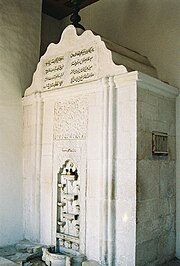
Khan Qirim Girai, is known to have authorized the construction of many landmarks in Bakhchysarai and the Crimean Khanate.
Khan Qirim Girai (?-1769), was one of the most influential rulers of the Crimean Khanate, he was the patron of the Bakhchisaray Fountain and many Mosques throughout Crimea, he is also known to have extended the Bakhchisaray Palace. Qirim Girai's first reign lasted (1758–1764), he was deposed by Selim III Giray, but regained power after the reign of Maqsud Giray. Qırım Giray's second reign lasted from (1768–1769).
Bakhchisaray Fountain[]

Fountain of Tears
Khan Qirim Girai, who in 1764 commissioned the fountain master Omer the Persian to construct the Bakhchisaray Fountain. The Bakhchisaray Fountain or Fountain of Tears is a real case of life imitating art. The fountain is known as the embodiment of love of one of the last Crimean Khans, Khan Qirim Girai for his young wife, and his grief after her early death. The Khan was said to have fallen in love with this Polish girl in his harem. Despite his battle-hardened harshness, he was grievous and wept when she died, astonishing all those who knew him. He commissioned a marble fountain to be made, so that the rock would weep, like him, forever.[1]
The tradition of building such Salsabil fountain is well established in Islamic architecture, especially in the cities of Baghdad and Damascus. Salsabil fountains often involved several basins, and sometimes channels that distributed water through basins and pools. Inscribed in gold above the Fountain of Tears is a verse of Surah 76 of the Quran, which names, among the benefits the righteous will enjoy including a spring, called "Salsabil". According to many Muslim scholars, the word Salsabil literally means "seek the way". It refers to a particular spring in heaven, and it also contains allusions to such concepts as "nectar," "smooth" and "easy on the throat". The Arabic word Sabil commonly refers to public fountains built for philanthropic purposes to provide water for wayfarers.
See also[]
References[]
- ↑ Johnstone, Sarah. Ukraine. Lonely Planet, 2005. ISBN 1-86450-336-X
The original article can be found at Qırım Giray and the edit history here.